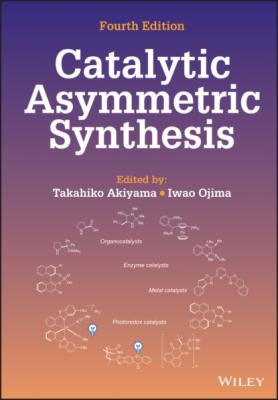Catalytic Asymmetric Synthesis. Группа авторов
Чтение книги онлайн.
Читать онлайн книгу Catalytic Asymmetric Synthesis - Группа авторов страница 61
 one [39]. This method features an enantioselective oxa‐Michael addition and dynamic kinetic resolution (DKR) involving reversible generation of chiral cyanohydrins 15 (Scheme 3.17). Amine‐thiourea 2o efficiently catalyzed the reaction to furnish the desired products in high yields with high diastereo‐ and enantioselectivities.
one [39]. This method features an enantioselective oxa‐Michael addition and dynamic kinetic resolution (DKR) involving reversible generation of chiral cyanohydrins 15 (Scheme 3.17). Amine‐thiourea 2o efficiently catalyzed the reaction to furnish the desired products in high yields with high diastereo‐ and enantioselectivities.
Scheme 3.17. Enantioselective synthesis of tetrahydropyrans with two stereogenic centers. Source: Based on [39].
Takemoto and co‐workers investigated the enantioselective intramolecular oxa‐Michael addition of α,β‐unsaturated amides and esters [40]. Because of the low reactivity of these Michael acceptors, the reaction with the conventional catalysts was rather sluggish. In contrast, catalyst 2p having a strong hydrogen bond donor unit efficiently promoted the reaction to provide the corresponding isoxazolidines in high yields with high enantioselectivities (Scheme 3.18). This catalyst system was also applicable to the synthesis of dihydrobenzofuran derivatives.
Scheme 3.18. Enantioselective intramolecular oxa‐Michael addition of α,β‐unsaturated amides catalyzed by 2p. Source: Based on [40].
Ghorai and co‐workers reported the enantioselective intramolecular oxa‐Michael addition of 4‐hydroxy cyclohexadienones 16 generated in situ via dearomatization of phenols [41]. The reaction was efficiently catalyzed by cinchona‐squaramide 2q, providing enantio‐enriched tetrahydrofurans attached to a cyclohexadienone moiety in spiro fashion (Scheme 3.19). The products were easily transformed into chromans without disturbing the enantiomeric purity by treating with a Lewis acid.
Scheme 3.19. Enantioselective intramolecular oxa‐Michael addition of in situ generated 4‐hydroxy cyclohexadienone via dearomatization of phenol catalyzed by 2q. Source: Based on [41].
Chiral bifunctional catalysts can also be applied to aza‐Michael addition reactions. For instance, Ghorai and co‐workers developed the intramolecular aza‐Michael addition of enamines to several Michael acceptors including ketones, esters, thioesters, and Weinreb amide [42]. The reaction proceeded efficiently by using cinchona alkaloid‐squaramide 2r as a catalyst to provide enantio‐enriched dihydroisoquinoline derivatives (Scheme 3.20).
Scheme 3.20. Enantioselective intramolecular aza‐Michael addition of enamines catalyzed by 2r. Source: Based on [42].
On the other hand, Dixon and co‐workers developed one‐pot catalytic enantioselective synthesis of 2‐pyrazolines, which involves the intermolecular aza‐Michael addition of hydrazone derivatives (Scheme 3.21) [43]. In this reaction, newly developed cinchona alkaloid‐derived 2s, which possesses a 3,5‐dichlorobenzoylamide moiety as a single hydrogen bond donor, was the optimum catalyst.
Scheme 3.21. One‐pot catalytic enantioselective synthesis of 2‐pyrazolines.
Source: Based on [43].
As an example of addition reactions of sulfur nucleophiles, Ellmann and co‐workers reported the enantioselective addition of thioacids to trisubstituted nitroalkenes catalyzed by cinchona alkaloid‐squaramide 2t (Scheme 3.22) [44]. This transformation constitutes the first example of nucleophilic addition to a trisubstituted nitroalkene followed by the enantioselective protonation.
Scheme 3.22. Enantioselective addition of thioacids to trisubstituted nitroalkenes catalyzed by 2t.
Source: Based on [44].
Liu, Li, and co‐workers developed the enantioselective addition of thiols to in situ generated ortho‐quinone methides 17 (Scheme 3.23) [45]. Cinchona alkaloid‐squaramide 2u was employed as a catalyst and water was used as a solvent. The control experiments suggested that water–oil biphase was crucial to achieve both high yields and high stereoselectivity in this reaction.
Scheme 3.23. Enantioselective addition of thiols to in situ generated ortho‐quinone methides catalyzed by 2u.
Source: Based on [45].
3.2.3. Other Applications
Enantioselective cascade reactions under organocatalysis have emerged as a powerful methodology for the efficient synthesis of complex molecules having multiple stereogenic centers in operationally simple protocols by using readily available precursors [46]. Chiral tertiary amine catalysts have also been utilized in a variety of enantioselective cascade reactions [20a]. Following are some selected examples of such reactions. Wang and co‐workers developed enantioselective Michael/cyclization reaction sequence for the synthesis of spirooxindoles [47]. The reaction of α‐isothiocyanato imides, esters, and lactones with alkylidene oxindoles was promoted by amine‐thiourea catalyst 2v to provide the corresponding spirooxindoles in high yields with high stereoselectivities (Scheme 3.24).